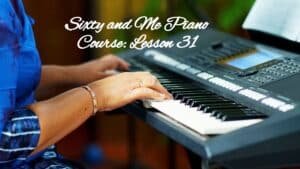
We’re going to look at some astonishing scientific evidence showing that complex activities such as taking music lessons “resulted in a 50% reduced risk of developing dementia” and that taking piano lessons, specifically, reduces our risk of cognitive decline and decreases depression symptoms. (Read one of the many amazing studies here.)
Aside from the cognitive benefits, piano lessons are fun! If you haven’t joined our free piano course, I hope you will consider giving it a try, now! Borrow a keyboard and try a few lessons. You can find my previous Sixty and Me Free Piano Lessons on my Author page. Join our lessons any time and move at your own pace! I am being sincere when I say, it’s never too late to learn to play the piano.
31.0 “Playing Music Is the Brain’s Equivalent of a Full Body Workout!”
Have you ever seen the Ted-Ed lesson on how playing an instrument is like “fireworks” going off in your brain? Through delightful animation, Anita Collins shows us that playing a musical instrument gives us a huge boost in brainpower. She tells us that “practice strengthens brain functions, allowing us to apply that strength to other activities.”
If you ever wondered why it’s difficult learning to play the piano, consider this: “Playing a musical instrument engages practically every area of the brain at once.” Watch this short video, I think you will enjoy it!
There have been many scientific studies for many years showing that musical training boosts cognitive function in older adults and that piano lessons, in particular, improve our quality of life, enhance our mood, and raise our ability to think effectively, to concentrate, and to remember new information. I love knowing that by studying and playing musical instruments along with exercising, I’m giving myself the best chance of maintaining optimal brain health.
And now, Welcome to Lesson 31! This week we are focusing on note reading, and we have a song, some drills and a puzzle to help us improve our skills.
31.1 Mystery Song and Some Puzzles to Solve, p.79-81
On p.79 you will play the Mystery Song and see if you can guess the tune. If you are American of a certain age, you will recognize this folk tune by a 19th century songwriter known as “The Father of American Music.”
If you are not American, this tune will not be familiar, so you will have to rely on your note reading and rhythm skills to figure out how to play it. And that’s what these two weeks will be all about – practicing your note reading through games, drills and song.
Once you think you are playing the song correctly, click on my ANSWERS link at the top of my website: UpperHandsPiano.com. Then click on p.79 (in BOOK 1) to find out the title of the Mystery Song, and the answers to the p.80 Word Search. (You can then search for this title on YouTube to hear the song performed by many artists.)
Click on “p.80 word search visually” to see all of the solutions for p. 80. Watch my video introducing this week’s lesson, and demonstrating one of the rhythms in the Mystery Song here:
Passion Practice
- Let’s revisit Exercise #2 (Appendix iii) in C and G, this time playing it with hands together. This is a great exercise for the brain and for finger agility. It might feel a little confusing playing it with hands together, but you are ready for this challenge!
- p.79 – Count and play the Mystery Song on p.79. Watch my video 31.1 above to hear how I count line two, measure 4, and line 3 measure 1. Remember Dotted Half Notes get 1½ counts (“1 & 2”) and are followed in this song by Eighth Notes which get ½ count (“&”). Fill in the letters to read the message below the song.
- p.80-81 As I suggested in my video, play the 2nd and 3rd lines on p. 80 – hands separately – before writing the letters next to the note heads. Try the Word Search for a fun brain teaser. For the first week, play the 1st line on p.80, forward and backward, saying the note names as you play. Then on your second week, play the 2nd line the same way.
- Chord Calisthenics – Let’s revisit Chord Calisthenics #1, this time playing with hands together! Do the whole page (Appendix vi), all 12 keys.
- Happy Spring! (If you are on my timeline, in the Northern Hemisphere, that is!) Review Spring, p.63. You can find the demonstration video and a reminder of how to play the repeats in Lesson 20.
Let’s Have a Conversation:
Have you noticed an increase in your ability to think clearly, concentrate and remember things since starting our piano lessons, as the scientific studies predict? Do you find that even when it feels challenging, playing the piano makes you feel better? I notice that sometimes if I am feeling worried, anxious or stressed, if I sit at the piano and fully engage in my practice, it lifts my spirits. Does that work for you? Leave a comment below and tell us about the effects of piano lessons on your mood and mind.




